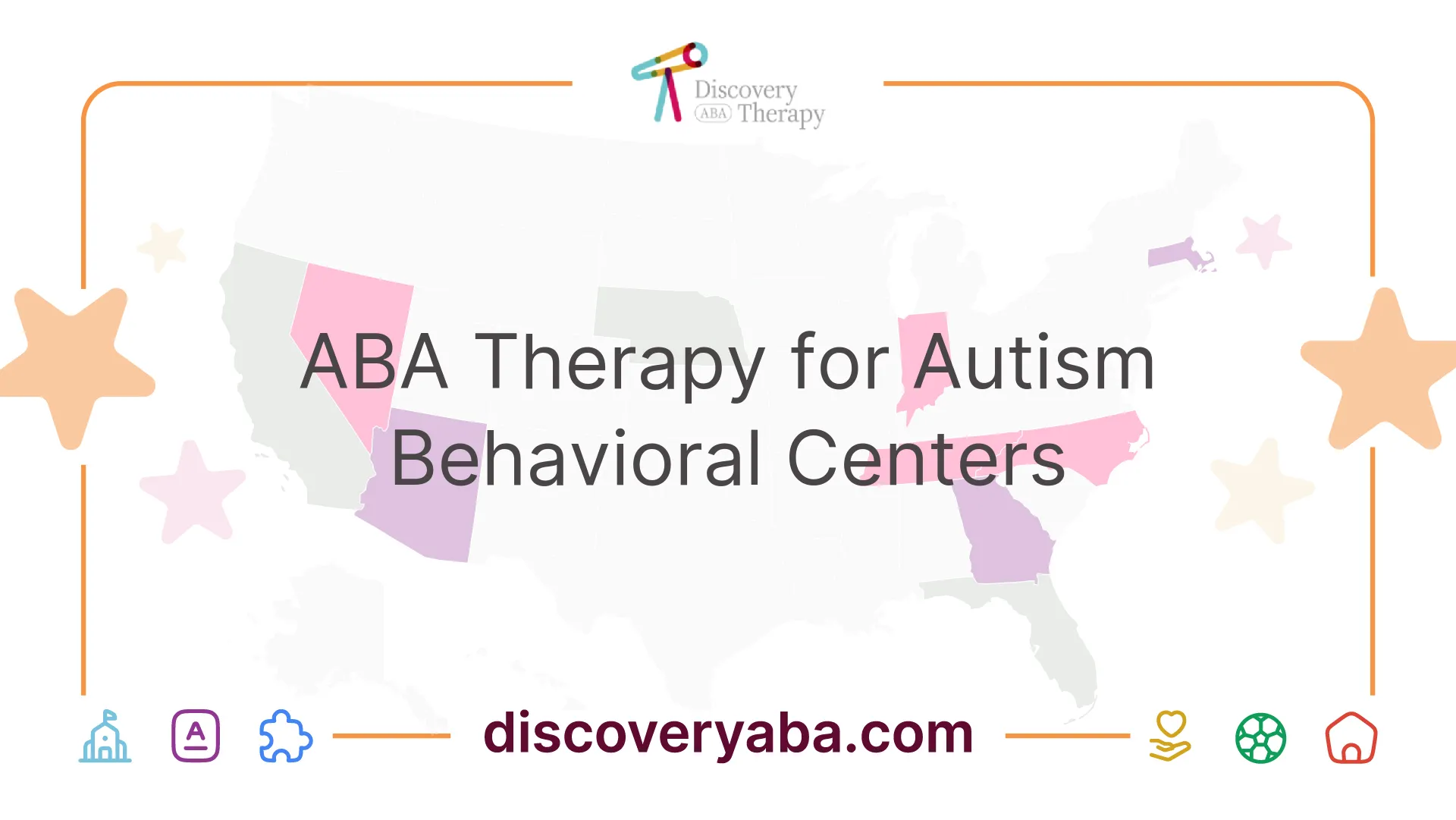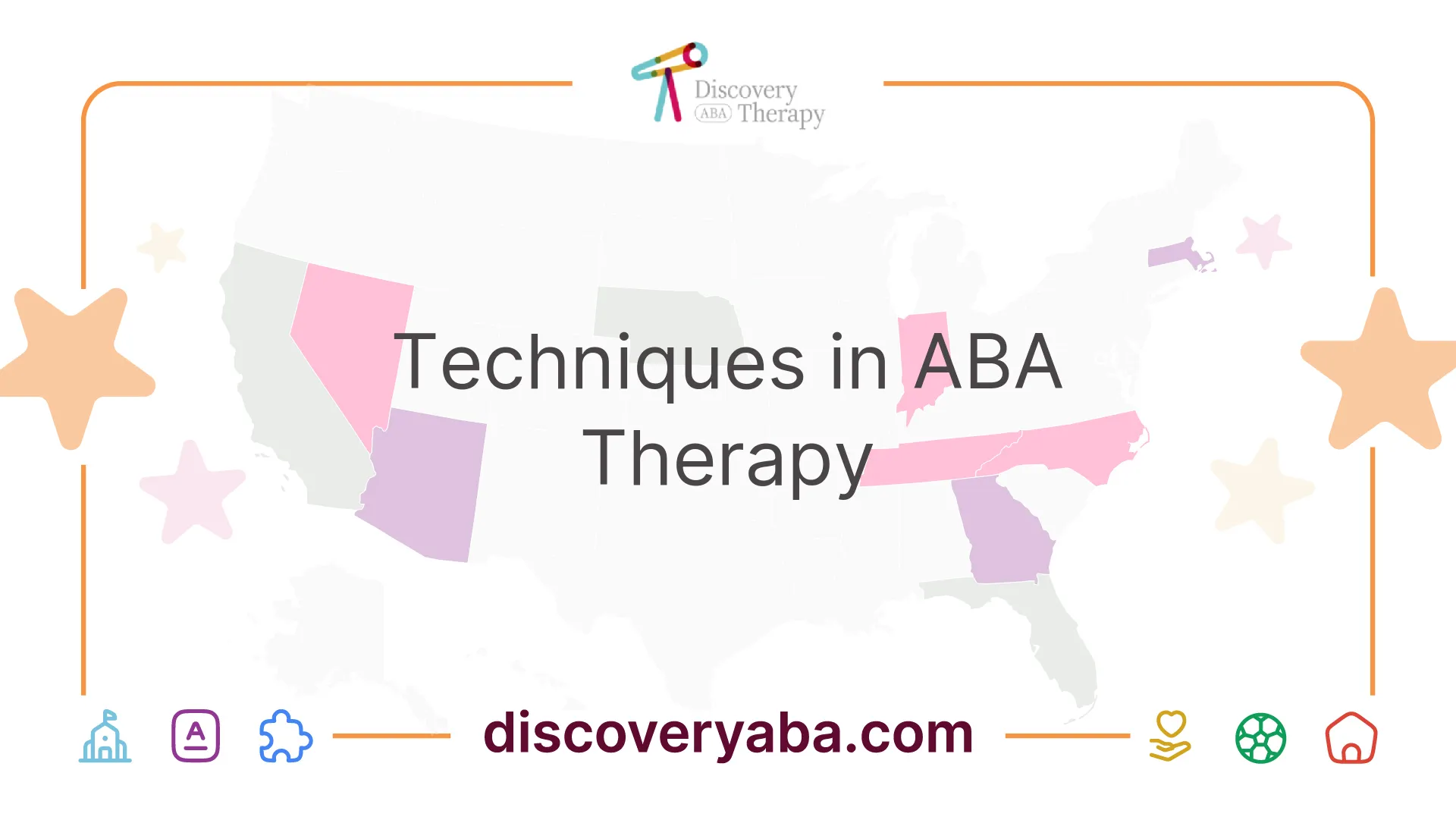ABA Therapy for Autism Behavioral Centers
Discover effective ABA therapy for autism behavioral centers and learn how it supports development and growth.


Understanding ABA Therapy
Basics of ABA Therapy
Applied Behavior Analysis (ABA) therapy involves utilizing both positive and negative reinforcement techniques consistently to teach children with autism what behaviors are appropriate and which are not. This systematic approach enables caregivers and therapists to create structured learning environments and target specific behavioral goals for each child [1].
ABA therapy is not a one-size-fits-all approach; rather, it's designed to be individualized based on the unique needs and challenges of each child. This customization ensures that the interventions used are most effective for each individual’s learning style and behavioral goals.
Key ComponentDescriptionFocusTeaching appropriate behaviorsTechniquesPositive and negative reinforcementIndividualizationTailored to meet unique needs
Principles of ABA Therapy
ABA therapy programs have been utilized to assist children with autism and related developmental disorders since the 1960s. Recognized as an evidence-based best practice treatment by the U.S. Surgeon General and the American Psychological Association, ABA is grounded in proven research and methodologies.
The principles of ABA are heavily influenced by the work of psychologist B.F. Skinner, who developed the theory of operant conditioning. This theory posits that behavior can be modified by changing the consequences that follow. By implementing consequences that either reinforce or punish certain behaviors, ABA aims to encourage positive behavior changes while reducing negative behaviors [3].
In practice, ABA therapy is tailored to meet the individual needs and goals of each person with Autism Spectrum Disorder (ASD). Behavior analysts primarily aim to enhance behavior in individuals with developmental disabilities, but their methods can also apply to anyone seeking behavioral modification.
PrincipleDescriptionHistorical UsageUsed since the 1960s for autism and related disordersEvidence-Based PracticeRecognized by major health organizationsOperant Conditioning FocusModify behavior through consequencesIndividual NeedsCustomized approaches for each child with ASD
ABA therapy represents a structured and scientifically-supported method for facilitating behavioral change and development in children with autism. For further exploration of ABA techniques, consider checking out our articles on aba therapy for autism behavioral programs and aba therapy for autism developmental centers.
Techniques in ABA Therapy

ABA therapy employs various techniques to effectively teach skills and promote behavioral change in individuals with autism. These techniques focus on creating an environment conducive to learning while tailoring approaches to meet individual needs. Three prominent techniques include video modeling, prompting and fading, and natural environment teaching.
Video Modeling
Video modeling is an effective ABA teaching tool that caters to visual learners. This technique allows children with autism to learn social interactions and emotional expressions by watching videos and imitating what they observe. By seeing appropriate behaviors modeled in various social situations, children can better understand and replicate these actions in real-life contexts.
Video Modeling BenefitsDescriptionEnhances UnderstandingHelps children grasp complex social cues and behaviors.Increases EngagementVisual format captures attention and encourages participation.Promotes ImitationChildren can practice observed behaviors in a safe setting.
Prompting and Fading
Prompting and fading is a technique that utilizes various prompts, either physical or verbal, to assist children in learning new skills. The goal of this method is to gradually reduce reliance on prompts to encourage independence in performing tasks [1].
Different levels of prompts may be implemented, starting from more intrusive (physical guidance) to less intrusive (verbal cues). As children become more proficient, the behavior analyst will fade prompts systematically, allowing children to become more self-sufficient.
Prompting TypesDescriptionPhysical PromptDirect assistance to perform the action.Verbal PromptCues or hints to guide the child's actions.Gestural PromptNon-verbal gestures to indicate what to do next.
Natural Environment Teaching
Natural environment teaching (NET) encourages children with autism to learn in real-life settings. This approach allows them to practice and generalize skills in authentic situations, such as interacting in grocery stores or within an ABA center [1]. By learning in contexts that resemble their daily lives, children can more effectively transfer the skills acquired during therapy to their everyday experiences.
Natural Environment BenefitsDescriptionReal-Life ApplicationSkills learned are applied in natural settings.Increased MotivationEngagement is often higher in familiar environments.Generalization of SkillsEnhances ability to use skills across different contexts.
These techniques are part of the broader definition of ABA therapy for autism behavioral centers, providing valuable insights into how therapy is customized to meet the unique needs of each individual. By integrating various strategies, ABA therapy effectively supports growth and development for children on the autism spectrum.
Individualized Treatment Plans

Individualized treatment plans are essential in ABA therapy for addressing the unique needs of individuals with autism. These plans often include behavior contracts, progress tracking, and skill-specific tracking, ensuring that each individual's therapy is tailored effectively.
Behavior Contracts
Behavior contracts are agreements between the therapist, the individual with autism, and often their caregivers. These contracts outline specific goals and expectations for behavior during therapy sessions. By defining clear objectives, behavior contracts help establish accountability and encourage the reinforcement of desired behaviors.
ComponentDescriptionGoalsSpecific, measurable objectives tailored to the individual's needsResponsibilitiesDefined roles for the therapist, individual, and caregiversRewardsIncentives for achieving goals, fostering motivation
These contracts serve as a roadmap for success, ensuring that everyone involved is on the same page regarding treatment goals. For additional insights on family involvement, consider exploring ABA therapy and autism family programs.
Progress Tracking
Progress tracking plays a vital role in autism therapy, enhancing intervention effectiveness and ensuring therapy is personalized [5]. Therapists utilize various assessment tools to monitor progress, allowing for necessary adjustments to be made to treatment plans.
In ABA, assessments and progress tracking methods often include:
MethodDescriptionData CollectionRegular recording of targeted behaviors during sessionsGraphing TrendsVisual analysis of progress over time to identify improvementsGoal ReassessmentRegular updates to objectives based on progress achieved
Setting specific, measurable, attainable, relevant, and time-bound (SMART) objectives is crucial in creating a roadmap for therapy and helps guide interventions [6]. Short-term goals are particularly important for building motivation and a foundation for long-term success.
Skill-Specific Tracking
Skill-specific tracking focuses on monitoring the development of particular skills during therapy sessions. This approach ensures that individuals are progressing on targeted skills, which can range from communication abilities to social interactions.
Common techniques for skill-specific tracking involve:
TechniqueDescriptionBehavior AssessmentsComprehensive evaluation of specific skills and behaviorsProgress LogsDetailed records of skill acquisition and areas needing improvementVisual RepresentationCharting progress visually to motivate and inform adjustments
By emphasizing specific skill development, therapists can fine-tune their approaches, providing more effective interventions tailored to the individual's progress towards mastery. For more on how ABA therapy supports specific developmental goals, visit ABA therapy for autism development services.
Overall, the use of individualized treatment plans, behavior contracts, progress tracking, and skill-specific tracking ensures that ABA therapy for autism is effective and responsive to each individual's needs.
Role of Behavior Analysts
Behavior analysts play a crucial role in the implementation of Applied Behavior Analysis (ABA) therapy for individuals with autism. They are responsible for developing and overseeing individualized treatment plans, ensuring the effectiveness of interventions tailored to the unique needs of each individual.
Board Certified Behavior Analysts (BCBAs)
Board Certified Behavior Analysts (BCBAs) are highly skilled professionals in the field of behavior analysis. They design and directly oversee ABA programs, customizing them to align with each learner's skills, needs, interests, preferences, and family situations. BCBAs are instrumental in conducting assessments to understand the strengths and areas needing improvement for individuals with autism, leading to personalized treatment strategies [2].
BCBAs hold a master's degree or higher in behavior analysis or a related field and have completed a rigorous certification process, which includes extensive supervised experience. They ensure that treatment is consistent with best practices and continually adjust programs as needed to maximize effectiveness.
RoleResponsibilitiesBCBADesign and oversee ABA programs, conduct assessments, customize treatment plans.
Board Certified Assistant Behavior Analysts (BCaBAs)
Board Certified Assistant Behavior Analysts (BCaBAs) work under the supervision of BCBAs. They hold an undergraduate-level certification in behavior analysis and assist in various tasks such as data collection, observation of ABA sessions, and training behavior technicians. BCaBAs support the implementation of treatment plans by ensuring fidelity in the execution of behavioral strategies and reporting progress to their supervising BCBAs.
Their input is vital in refining the therapy approach based on real-time data gathered during sessions.
RoleResponsibilitiesBCaBAAssist in data collection, observe sessions, train behavior technicians.
Registered Behavior Technicians (RBTs)
Registered Behavior Technicians (RBTs) are paraprofessionals who work directly with clients under the supervision of BCBAs and BCaBAs. They assist in the implementation of behavioral strategies as outlined in treatment plans. RBTs are required to complete 40 hours of qualified training and pass a certification exam to ensure they possess the necessary skills to support individuals effectively [7].
RBTs play a crucial role in the daily application of ABA techniques, helping to draw connections between targeted behaviors and broader behavioral objectives. Their contributions ensure that therapy is consistently delivered and closely monitored.
RoleResponsibilitiesRBTImplement ABA strategies, collect data, support clients in daily activities.
The collaborative efforts of BCBAs, BCaBAs, and RBTs create a comprehensive support network for individuals with autism, driving effective treatment and positive outcomes. This team approach is vital in delivering ABA therapy for autism behavioral centers that meet the unique needs of each client.
Effectiveness of ABA Therapy
ABA therapy plays a crucial role in supporting individuals with autism. This section examines the research supporting its effectiveness, the benefits it offers, and the evidence-based best practices that characterize successful interventions.
Research on ABA Therapy
ABA therapy programs have been employed since the 1960s to assist children with autism and related developmental disorders. According to various studies, more than 20 studies have established that intensive and long-term therapy using ABA principles significantly improves outcomes for many children with autism. These outcomes include enhancements in intellectual functioning, language development, daily living skills, and social functioning [2].
A summary of key research findings on ABA therapy is presented in the table below.
Study FocusFindingsLong-Term OutcomesImproved overall functioning in children with autism.Language DevelopmentSignificant gains in the ability to communicate effectively.Daily Living SkillsEnhanced independence in day-to-day activities.Social SkillsBetter interaction and engagement with peers.
Benefits of ABA Therapy
ABA therapy offers a broad range of advantages for individuals with autism. Here are some notable benefits:
Evidence-Based Best Practices
ABA is considered an evidence-based best practice treatment by prominent authorities, including the US Surgeon General and the American Psychological Association. Key best practices in ABA therapy include:
Parents and caregivers interested in the effectiveness of ABA therapy can explore various resources and support programs in the field. Delving into topics such as aba therapy for autism behavior programs and aba therapy for autism treatment services can offer additional insights into how this therapy can benefit their loved ones.
Practical Aspects of ABA Therapy
Understanding the practical aspects of ABA therapy is essential for parents and caregivers of individuals with autism. This includes information on family involvement, costs associated with therapy, and the necessary licensing and certification requirements for practitioners.
Family Involvement
Family involvement plays a crucial role in the success of ABA therapy. It is not only important for the individual undergoing treatment but also beneficial for the entire family unit. Engaging family members in the therapeutic process helps to reinforce learned skills outside of therapy sessions. Activities designed for the family can promote understanding and consistency in applying techniques taught during sessions. Programs like ABA therapy and autism family programs can help families navigate this journey together, enabling a supportive environment for the individual.
Costs of ABA Therapy
The expenses associated with ABA therapy can be significant. Typically delivered one-on-one by a trained therapist for more than 10 hours per week, the annual cost often exceeds $20,000. While many health insurance plans do cover a portion of these costs, families should be prepared to meet their out-of-pocket maximums based on their specific insurance coverage [8].
Cost ElementsApproximate AmountsAnnual Cost of Services> $20,000Typical Therapy Hours per Week> 10 hoursOut-of-Pocket MaximumVaries by insurer
Being informed about the expected costs helps families plan accordingly and seek financial assistance or guidance when necessary. There are various resources for families looking for funding options or financial support, including ABA therapy for autism behavioral programs.
Licensing and Certification Requirements
To ensure quality care, practitioners of ABA therapy must meet specific licensing and certification standards. In most states, ABA therapists are required to be licensed, with varying requirements based on state regulations. Certification as a Board Certified Behavior Analyst (BCBA) is essential for ABA therapists to practice and facilitate insurance billing [9].
Practitioner RoleRequired CertificationsBoard Certified Behavior Analyst (BCBA)Must hold BCBA certificationBoard Certified Assistant Behavior Analyst (BCaBA)BCaBA certification is requiredRegistered Behavior Technician (RBT)Completion of RBT training and certification required
Each of these roles contributes uniquely to the delivery of ABA therapy, ensuring that interventions are tailored to each learner's abilities and needs. For families seeking effective support, understanding these credentials helps in selecting qualified professionals for their loved ones. Resources such as ABA therapy for autism treatment services can provide further guidance on finding the right therapy options.
References
[2]:
[3]:
[4]:
[5]:
[6]:
[7]:
[8]:
[9]:
Does Your Child Have An Autism Diagnosis?
Learn More About How ABA Therapy Can Help
Find More Articles
Contact us
North Carolina, Nevada, Utah, Virginia
New Hampshire, Maine
Arizona, Colorado, Georgia, New Mexico, Oklahoma, Texas
.avif)


































































































